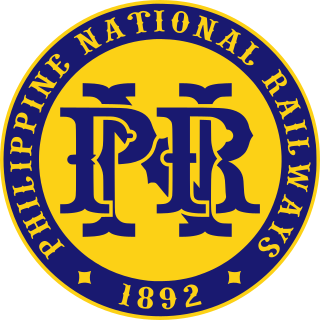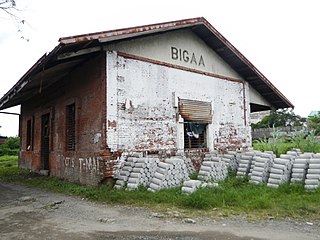
The Philippine National Railways also known as (PNR) is a state-owned railway company in the Philippines, operating a single line of track on Luzon. As of 2016, it operates one commuter rail service in Metro Manila and local services between Sipocot, Naga City and Legazpi City in the Bicol Region. PNR began operations on November 24, 1892 as the Ferrocarril de Manila-Dagupan, during the Spanish colonial period, and later becoming the Manila Railroad Company (MRR) during the American colonial period. It became the Philippine National Railways on June 20, 1964 by virtue of Republic Act No. 4156. The PNR is an agency of the Department of Transportation.

Valenzuela,, officially the City of Valenzuela, or simply known as Valenzuela City, is a 1st class highly urbanized city in Metropolitan Manila, Philippines. According to the 2015 census, it has a population of 620,422 people.

The North Luzon Expressway, formerly known as the North Diversion Road and Manila North Expressway (MNEX), is a 4 to 8-lane limited-access toll expressway that connects Metro Manila to the provinces of the Central Luzon region in the Philippines. It is a component of Expressway 1 (E1) of the Philippine expressway network, Circumferential Road 5 (C-5) and Radial Road 8 (R-8) of Manila's arterial road network. It was built in the 1960s.

Rail transportation in the Philippines is currently used mostly to transport passengers within Metro Manila and the nearby province of Laguna, as well as a commuter service in the Bicol Region. Freight transport services once operated in the country, but these services were halted. However, there are plans to restore old freight services and build new lines.

The Strong Republic Transit System was launched to integrate the various rail lines providing public transport in Manila in the Philippines. The program was initiated by former president Gloria Macapagal-Arroyo on June 14, 2003. It aimed to provide a "reliable, seamless and integrated mass transit system that would be at par with international standards" through the unification of already-existing rail infrastructure under one transit system and fare structure. The Manila Light Rail Transit System, the Manila Metro Rail Transit System and the Philippine National Railways (PNR) Northrail and Southrail lines were covered by the SRTS project.

San Fernando City station or simply San Fernando station is a defunct railway station of the PNR Northrail line of Philippine National Railways. It is situated San Fernando, Pampanga. Historically, the old PNR train station was the site of a stopping place for Filipino and American prisoners of war during the Bataan death march in 1942.
The public transportation system in Metro Manila, Philippines is inadequate to accommodate the mobility and other basic needs of a densely populated metropolis, the result of many factors and problems that the government has failed to deliver. Metro Manila exists in a state of heavy traffic congestion, with people and goods trapped by the very transportation system that is supposed to move them quickly and efficiently. Because of the insufficient public transportation network, car ownership has risen dramatically, contributing further to the congestion that occurs at all times of day on the road. Filipinos view cars as tools to get them to where they need to go; they also believe that their car is an important symbol of the success they have achieved in life. In recent years, however, the Philippine government has been pushing to improve the system through various infrastructure projects, hoping to solve the interlinked problems of transportation, land use and environment.

The transportation system in Metro Manila is currently inadequate to accommodate the mobility and other basic needs of an densely populated metropolis, the result of many factors and problems that the government has failed to provide or address. Metro Manila exists in a state of near-permanent gridlock, with people and goods trapped by the very transportation system that is supposed to move them quickly and efficiently.
Marilao railway station was a former railroad station in the Philippine National Railways' Dagupan line, and is also a proposed railway station that is situated on the Northrail line. This line has been used for passenger and freight transportation by Philippine National Railways and its precursors in the past.

Bocaue railway station is a former railway station that was situated on the Northrail line. This line has in the past been used for passenger and freight transportation by Philippine National Railways and its precursors. It was located approximately 1 kilometer to the north of Bocaue proper.

Estacion de Guiguinto is a former railway station that is situated on the Northrail line. This line has been used for passenger and freight transportation by Philippine National Railways and its precursors in the past. it is located in Poblacion, Guiguinto, Bulacan. The train station is parallel to Mc Arthur Highway, it is near with the San Ildefonso de Toledo Church and to the Municipal Hall.

Calumpit station is a former railway station of the Ferrocarril de Manila-Dagupan, now the Philippine National Railways
Apalit railway station is a former railway station of the Northrail line of Philippine National Railways.

Caloocan railway station is a railway station of the Philippine National Railways (PNR) as part of the Governor Pascual - FTI line. It is rebuilt from its original location, now located and situated adjacent to Apolinario Mabini St., and along the railroad crossing on Samson Road in Caloocan, Metro Manila.

Balagtas or Bigaa station is one of the stations of the abandoned Northrail line of PNR. The station served as a terminus for the defunct Balagtas-Cabanatuan line.

The Philippine National Railways Metro Commuter Line is a commuter rail line operated by the Philippine National Railways, stretching from Tondo, Manila to the southern and northern edge of Metro Manila. Presently, there are 31 railway stations. The current line is colored orange on most maps.

The Metro Manila Subway Line 9, formerly known as the Mega Manila Subway, is an underground rapid transit line currently under construction in Metro Manila, Philippines. The 36-kilometer (22 mi) line, which will run north–south between Quezon City, Pasig, Makati, Taguig, and Pasay, consists of 15 stations between the Quirino Highway and FTI stations. It will become the country's second direct airport rail link after the North–South Commuter Railway, with a branch line to Ninoy Aquino International Airport.

Governor Pascual railway station is a railway station of the Philippine National Railways (PNR), the current terminus of the Metro North Commuter and the North Shuttle line. It is located and situated adjacent to Governor Pascual Avenue, Barangay Acacia in Malabon, Metro Manila.

Meycauayan railway station was a former railroad station in the Philippine National Railways' Dagupan line, and is also a proposed railway station that is situated on the Northrail line. This line has been used for passenger and freight transportation by Philippine National Railways and its precursors in the past.

The North–South Commuter Railway (NSCR), also known as the Clark–Calamba Railway, is a 148 km (92 mi) urban rail transit line being constructed in Luzon. It will run from New Clark City in Capas, Tarlac to Calamba, Laguna with 36 stations, with historic stations to be restored.
















